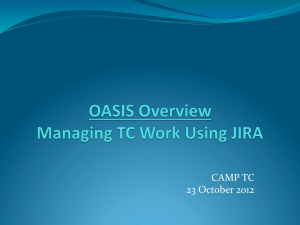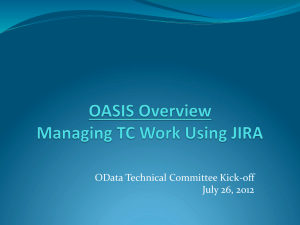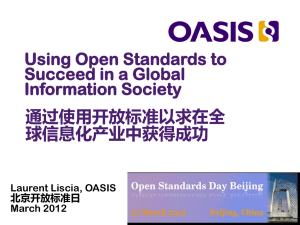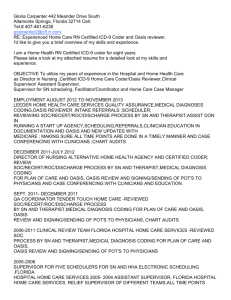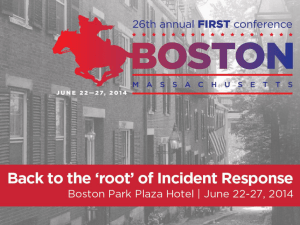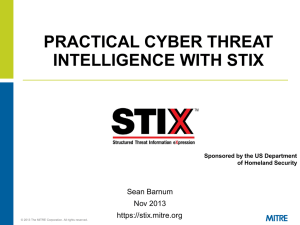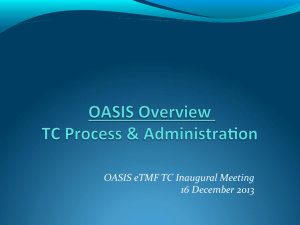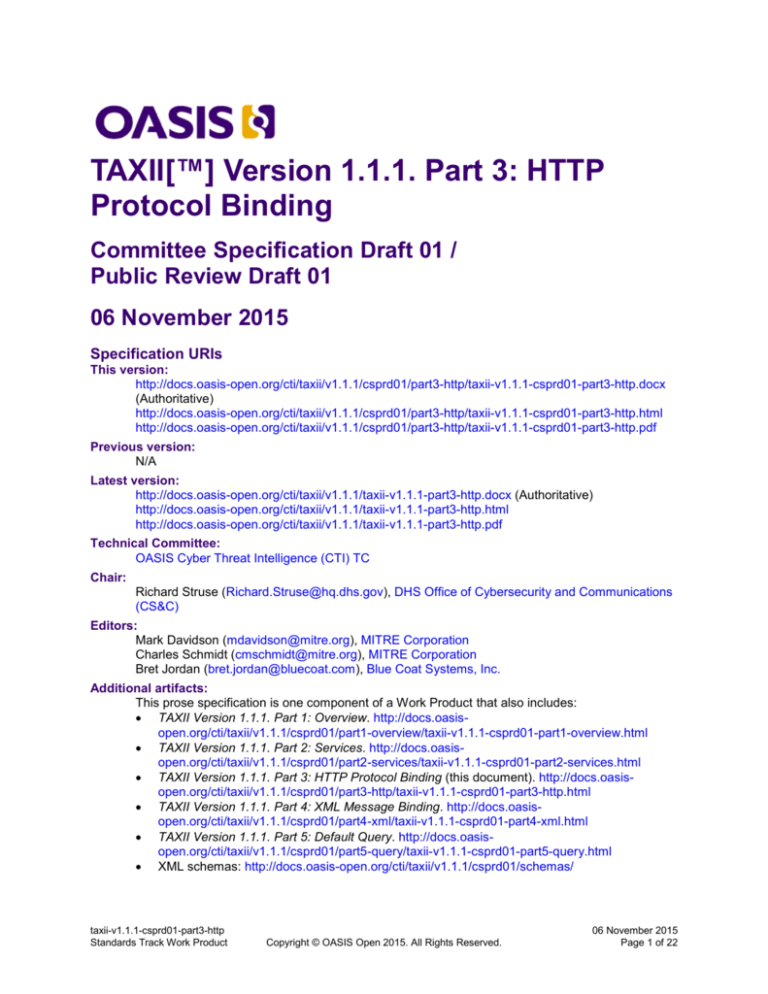
TAXII[™] Version 1.1.1. Part 3: HTTP
Protocol Binding
Committee Specification Draft 01 /
Public Review Draft 01
06 November 2015
Specification URIs
This version:
http://docs.oasis-open.org/cti/taxii/v1.1.1/csprd01/part3-http/taxii-v1.1.1-csprd01-part3-http.docx
(Authoritative)
http://docs.oasis-open.org/cti/taxii/v1.1.1/csprd01/part3-http/taxii-v1.1.1-csprd01-part3-http.html
http://docs.oasis-open.org/cti/taxii/v1.1.1/csprd01/part3-http/taxii-v1.1.1-csprd01-part3-http.pdf
Previous version:
N/A
Latest version:
http://docs.oasis-open.org/cti/taxii/v1.1.1/taxii-v1.1.1-part3-http.docx (Authoritative)
http://docs.oasis-open.org/cti/taxii/v1.1.1/taxii-v1.1.1-part3-http.html
http://docs.oasis-open.org/cti/taxii/v1.1.1/taxii-v1.1.1-part3-http.pdf
Technical Committee:
OASIS Cyber Threat Intelligence (CTI) TC
Chair:
Richard Struse (Richard.Struse@hq.dhs.gov), DHS Office of Cybersecurity and Communications
(CS&C)
Editors:
Mark Davidson (mdavidson@mitre.org), MITRE Corporation
Charles Schmidt (cmschmidt@mitre.org), MITRE Corporation
Bret Jordan (bret.jordan@bluecoat.com), Blue Coat Systems, Inc.
Additional artifacts:
This prose specification is one component of a Work Product that also includes:
TAXII Version 1.1.1. Part 1: Overview. http://docs.oasisopen.org/cti/taxii/v1.1.1/csprd01/part1-overview/taxii-v1.1.1-csprd01-part1-overview.html
TAXII Version 1.1.1. Part 2: Services. http://docs.oasisopen.org/cti/taxii/v1.1.1/csprd01/part2-services/taxii-v1.1.1-csprd01-part2-services.html
TAXII Version 1.1.1. Part 3: HTTP Protocol Binding (this document). http://docs.oasisopen.org/cti/taxii/v1.1.1/csprd01/part3-http/taxii-v1.1.1-csprd01-part3-http.html
TAXII Version 1.1.1. Part 4: XML Message Binding. http://docs.oasisopen.org/cti/taxii/v1.1.1/csprd01/part4-xml/taxii-v1.1.1-csprd01-part4-xml.html
TAXII Version 1.1.1. Part 5: Default Query. http://docs.oasisopen.org/cti/taxii/v1.1.1/csprd01/part5-query/taxii-v1.1.1-csprd01-part5-query.html
XML schemas: http://docs.oasis-open.org/cti/taxii/v1.1.1/csprd01/schemas/
taxii-v1.1.1-csprd01-part3-http
Standards Track Work Product
Copyright © OASIS Open 2015. All Rights Reserved.
06 November 2015
Page 1 of 22
Related work:
This specification replaces or supersedes:
The TAXII HTTP Protocol Binding Specification Version 1.0.
http://taxiiproject.github.io/releases/1.0/TAXII_HTTPProtocolBinding_Specification.pdf.
This specification is related to:
TAXII Content Binding Reference.
http://taxiiproject.github.io/releases/1.1/TAXII_ContentBinding_Reference_v3.pdf
Declared XML namespaces:
http://docs.oasis-open.org/cti/ns/taxii/xml/binding-1.1.1
http://docs.oasis-open.org/cti/ns/taxii/default-query-1.1.1
Abstract:
This document describes HTTP Protocol Binding.
Status:
This document was last revised or approved by the OASIS Cyber Threat Intelligence (CTI) TC on
the above date. The level of approval is also listed above. Check the “Latest version” location
noted above for possible later revisions of this document. Any other numbered Versions and
other technical work produced by the Technical Committee (TC) are listed at https://www.oasisopen.org/committees/tc_home.php?wg_abbrev=cti#technical.
TC members should send comments on this specification to the TC’s email list. Others should
send comments to the TC’s public comment list, after subscribing to it by following the
instructions at the “Send A Comment” button on the TC’s web page at https://www.oasisopen.org/committees/cti/.
For information on whether any patents have been disclosed that may be essential to
implementing this specification, and any offers of patent licensing terms, please refer to the
Intellectual Property Rights section of the TC’s web page (https://www.oasisopen.org/committees/cti/ipr.php).
Citation format:
When referencing this specification the following citation format should be used:
[TAXII-v1.1.1-HTTP]
TAXII[™] Version 1.1.1. Part 3: HTTP Protocol Binding. Edited by Mark Davidson, Charles
Schmidt, and Bret Jordan. 06 November 2015. OASIS Committee Specification Draft 01 / Public
Review Draft 01. http://docs.oasis-open.org/cti/taxii/v1.1.1/csprd01/part3-http/taxii-v1.1.1csprd01-part3-http.html. Latest version: http://docs.oasis-open.org/cti/taxii/v1.1.1/taxii-v1.1.1part3-http.html.
taxii-v1.1.1-csprd01-part3-http
Standards Track Work Product
Copyright © OASIS Open 2015. All Rights Reserved.
06 November 2015
Page 2 of 22
Notices
Copyright © OASIS Open 2015. All Rights Reserved.
All capitalized terms in the following text have the meanings assigned to them in the OASIS Intellectual
Property Rights Policy (the "OASIS IPR Policy"). The full Policy may be found at the OASIS website.
This document and translations of it may be copied and furnished to others, and derivative works that
comment on or otherwise explain it or assist in its implementation may be prepared, copied, published,
and distributed, in whole or in part, without restriction of any kind, provided that the above copyright notice
and this section are included on all such copies and derivative works. However, this document itself may
not be modified in any way, including by removing the copyright notice or references to OASIS, except as
needed for the purpose of developing any document or deliverable produced by an OASIS Technical
Committee (in which case the rules applicable to copyrights, as set forth in the OASIS IPR Policy, must
be followed) or as required to translate it into languages other than English.
The limited permissions granted above are perpetual and will not be revoked by OASIS or its successors
or assigns.
This document and the information contained herein is provided on an "AS IS" basis and OASIS
DISCLAIMS ALL WARRANTIES, EXPRESS OR IMPLIED, INCLUDING BUT NOT LIMITED TO ANY
WARRANTY THAT THE USE OF THE INFORMATION HEREIN WILL NOT INFRINGE ANY
OWNERSHIP RIGHTS OR ANY IMPLIED WARRANTIES OF MERCHANTABILITY OR FITNESS FOR A
PARTICULAR PURPOSE.
OASIS requests that any OASIS Party or any other party that believes it has patent claims that would
necessarily be infringed by implementations of this OASIS Committee Specification or OASIS Standard,
to notify OASIS TC Administrator and provide an indication of its willingness to grant patent licenses to
such patent claims in a manner consistent with the IPR Mode of the OASIS Technical Committee that
produced this specification.
OASIS invites any party to contact the OASIS TC Administrator if it is aware of a claim of ownership of
any patent claims that would necessarily be infringed by implementations of this specification by a patent
holder that is not willing to provide a license to such patent claims in a manner consistent with the IPR
Mode of the OASIS Technical Committee that produced this specification. OASIS may include such
claims on its website, but disclaims any obligation to do so.
OASIS takes no position regarding the validity or scope of any intellectual property or other rights that
might be claimed to pertain to the implementation or use of the technology described in this document or
the extent to which any license under such rights might or might not be available; neither does it
represent that it has made any effort to identify any such rights. Information on OASIS' procedures with
respect to rights in any document or deliverable produced by an OASIS Technical Committee can be
found on the OASIS website. Copies of claims of rights made available for publication and any
assurances of licenses to be made available, or the result of an attempt made to obtain a general license
or permission for the use of such proprietary rights by implementers or users of this OASIS Committee
Specification or OASIS Standard, can be obtained from the OASIS TC Administrator. OASIS makes no
representation that any information or list of intellectual property rights will at any time be complete, or
that any claims in such list are, in fact, Essential Claims.
The name "OASIS" is a trademark of OASIS, the owner and developer of this specification, and should be
used only to refer to the organization and its official outputs. OASIS welcomes reference to, and
implementation and use of, specifications, while reserving the right to enforce its marks against
misleading uses. Please see https://www.oasis-open.org/policies-guidelines/trademark for above
guidance.
Portions copyright © United States Government 2012-2015. All Rights Reserved.
STIX[™], TAXII[™], AND CybOX[™] (STANDARD OR STANDARDS) AND THEIR COMPONENT
PARTS ARE PROVIDED “AS IS” WITHOUT ANY WARRANTY OF ANY KIND, EITHER EXPRESSED,
IMPLIED, OR STATUTORY, INCLUDING, BUT NOT LIMITED TO, ANY WARRANTY THAT THESE
STANDARDS OR ANY OF THEIR COMPONENT PARTS WILL CONFORM TO SPECIFICATIONS, ANY
taxii-v1.1.1-csprd01-part3-http
Standards Track Work Product
Copyright © OASIS Open 2015. All Rights Reserved.
06 November 2015
Page 3 of 22
IMPLIED WARRANTIES OF MERCHANTABILITY, FITNESS FOR A PARTICULAR PURPOSE, OR
FREEDOM FROM INFRINGEMENT, ANY WARRANTY THAT THE STANDARDS OR THEIR
COMPONENT PARTS WILL BE ERROR FREE, OR ANY WARRANTY THAT THE DOCUMENTATION,
IF PROVIDED, WILL CONFORM TO THE STANDARDS OR THEIR COMPONENT PARTS. IN NO
EVENT SHALL THE UNITED STATES GOVERNMENT OR ITS CONTRACTORS OR
SUBCONTRACTORS BE LIABLE FOR ANY DAMAGES, INCLUDING, BUT NOT LIMITED TO, DIRECT,
INDIRECT, SPECIAL OR CONSEQUENTIAL DAMAGES, ARISING OUT OF, RESULTING FROM, OR
IN ANY WAY CONNECTED WITH THESE STANDARDS OR THEIR COMPONENT PARTS OR ANY
PROVIDED DOCUMENTATION, WHETHER OR NOT BASED UPON WARRANTY, CONTRACT, TORT,
OR OTHERWISE, WHETHER OR NOT INJURY WAS SUSTAINED BY PERSONS OR PROPERTY OR
OTHERWISE, AND WHETHER OR NOT LOSS WAS SUSTAINED FROM, OR AROSE OUT OF THE
RESULTS OF, OR USE OF, THE STANDARDS, THEIR COMPONENT PARTS, AND ANY PROVIDED
DOCUMENTATION. THE UNITED STATES GOVERNMENT DISCLAIMS ALL WARRANTIES AND
LIABILITIES REGARDING THE STANDARDS OR THEIR COMPONENT PARTS ATTRIBUTABLE TO
ANY THIRD PARTY, IF PRESENT IN THE STANDARDS OR THEIR COMPONENT PARTS AND
DISTRIBUTES IT OR THEM “AS IS.”
taxii-v1.1.1-csprd01-part3-http
Standards Track Work Product
Copyright © OASIS Open 2015. All Rights Reserved.
06 November 2015
Page 4 of 22
Table of Contents
1
Introduction ........................................................................................................................................... 6
1.1 The TAXII[™] HTTP Protocol Binding Specification ........................................................................... 6
1.1.1 Conformance to HTTP/1.1 .......................................................................................................... 6
1.1.2 TAXII[™] Protocol Version ID for HTTP and HTTPS .................................................................. 6
1.2 Terminology ........................................................................................................................................ 6
1.3 Normative References ........................................................................................................................ 6
2
TAXII[™] HTTP Header ........................................................................................................................ 8
2.1.1 Accept .......................................................................................................................................... 8
2.1.2 Content-Type ............................................................................................................................... 9
2.1.3 X-TAXII-Accept ............................................................................................................................ 9
2.1.4 X-TAXII-Content-Type ................................................................................................................. 9
2.1.5 X-TAXII-Protocol ....................................................................................................................... 10
2.1.6 X-TAXII-Services ....................................................................................................................... 10
3
HTTP Requests .................................................................................................................................. 11
4
HTTP Responses ............................................................................................................................... 12
5
Handling Responses without TAXII[™] Messages ............................................................................. 13
5.1 HTTP Responses as TAXII[™] Status Messages ............................................................................ 13
5.2 TLS Alerts as TAXII[™] Status Messages ........................................................................................ 13
6
Security Considerations ..................................................................................................................... 15
6.1 Server Authentication ....................................................................................................................... 15
6.2 Client Authentication ......................................................................................................................... 15
6.3 Encryption and Integrity Protection ................................................................................................... 15
7
Recommended Configurations ........................................................................................................... 16
8
Conformance ...................................................................................................................................... 17
Appendix A. Acknowledgments .................................................................................................................. 18
Appendix B. Revision History ...................................................................................................................... 22
taxii-v1.1.1-csprd01-part3-http
Standards Track Work Product
Copyright © OASIS Open 2015. All Rights Reserved.
06 November 2015
Page 5 of 22
1 Introduction
The TAXII[™] HTTP Protocol Binding Specification defines requirements for using HTTP/1.1 or HTTP
Over TLS [RFC5246] to participate in TAXII Message Exchanges (i.e., send and receive TAXII
Messages). This document normatively references HTTP/1.1, defining extensions and restrictions of
HTTP/1.1 where necessary to support TAXII Services and TAXII Message Exchanges. Readers should
familiarize themselves with the TAXII Services Specification and the HTTP/1.1 specification [RFC 2616]
prior to reading this document.
1.1 The TAXII[™] HTTP Protocol Binding Specification
This specification provides normative text on the transmission of TAXII Messages using HTTP[RFC2616]
and HTTPS. It does not provide details about how TAXII Messages are expressed, leaving that to a
Message Binding Specification. The TAXII Services and TAXII Message Exchanges that TAXII Messages
support are discussed in detail in the TAXII Services Specification.
1.1.1 Conformance to HTTP/1.1
In order to be compliant with this specification, an implementation MUST conform to the HTTP/1.1
specification in addition to the requirements in this document. Some requirements in this document are
restrictions and extensions of HTTP/1.1. This document re-uses concepts and terms from HTTP/1.1
where possible and includes a reference to the relevant section of HTTP/1.1 when doing so.
1.1.2 TAXII[™] Protocol Version ID for HTTP and HTTPS
This specification defines two TAXII Protocol Version IDs, one for HTTP and one for HTTPS (HTTP Over
TLS). These two Version IDs are provided to disambiguate between TAXII Services that that support
HTTP and those that support HTTPS.
The TAXII Protocol Version IDs for the version of the TAXII HTTP and HTTPS Bindings described in this
specification are:
urn:oasis:cti:taxii:http:1.1.1
and
urn:oasis:cti:taxii:https:1.1.1
1.2 Terminology
The key words “MUST”, “MUST NOT”, “REQUIRED”, “SHALL”, “SHALL NOT”, “SHOULD”, “SHOULD
NOT”, “RECOMMENDED”, “MAY”, and “OPTIONAL” in this document are to be interpreted as described
in [RFC2119].
1.3 Normative References
[Fielding, 1999]
R. Fielding, J. Gettys, J. Mogul, H. Frystyk, L. Masinter, P. Leach and T. BernersLee, "RFC 2616 - Hypertext Transfer Protocol -- HTTP/1.1," The Internet
Engineering Task Force, 1999.
taxii-v1.1.1-csprd01-part3-http
Standards Track Work Product
Copyright © OASIS Open 2015. All Rights Reserved.
06 November 2015
Page 6 of 22
[RFC2818]
E. Rescorla, " HTTP Over TLS", RFC 2818, May 2000.
https://tools.ietf.org/html/rfc2818
[RFC2616]
R. Fielding, J. Gettys, J. Mogul, H. Frystyk, L. Masinter, P. Leach and T. BernersLee, “Hypertext Transfer Protocol -- HTTP/1.1”, May 2000.
https://www.ietf.org/rfc/rfc2616.txt
[RFC2119]
Bradner, S., “Key words for use in RFCs to Indicate Requirement Levels”, BCP
14, RFC 2119, March 1997. http://www.ietf.org/rfc/rfc2119.txt.
[IANA, 2006]
Internet Assigned Numbers Authority, 2006. [Online]. Available:
http://www.iana.org/assignments/media-types/application/index.html. [Accessed
2012].
[RFC5246]
T. Dierks and E. Rescorla, "The Transport Layer Security (TLS) Protocol Version
1.2", RFC 5246, August 2008. https://tools.ietf.org/html/rfc5246
taxii-v1.1.1-csprd01-part3-http
Standards Track Work Product
Copyright © OASIS Open 2015. All Rights Reserved.
06 November 2015
Page 7 of 22
2 TAXII[™] HTTP Header
This section defines requirements for TAXII HTTP Headers. The term TAXII HTTP Headers refers to
HTTP headers whose values are restricted by this specification, as well as HTTP X-Headers defined by
this specification. HTTP Headers not mentioned in this section retain their original definitions and
requirements from HTTP/1.1.
Table 1 provides a list of the TAXII HTTP Headers and a brief description of each.
Table 1 - HTTP Headers
Header
Description
Accept
Specifies which HTTP Media Types the requestor accepts in
response.
Content-Type
Specifies the HTTP Media Type in which the entity body is
formatted.
X-TAXII-Accept
Specifies which TAXII Message Bindings the requestor accepts
in response.
X-TAXII-Content-Type
Specifies the TAXII Message Binding in which the entity body is
formatted.
X-TAXII-Protocol
Specifies which TAXII Protocol Binding is used for this message.
X-TAXII-Services
Specifies the version of the TAXII Services Specification to
which this message conforms.
2.1.1 Accept
HTTP/1.1, Section 14.1 describes the Accept header:
The Accept request-header field can be used to specify certain media types which are acceptable for the
response.
The Accept header field, if present, follows the guidance in HTTP/1.1 with the following restrictions:
1. All media-ranges MUST have a type of 'application'
2. All media-ranges SHOULD have a subtype that is defined in the MIME Media Types IANA Table
(Internet Assigned Numbers Authority 2006) as an application subtype.
3. If the X-TAXII-Accept header (described in Section 2.1.3) is present, the subtype of each mediarange MUST agree with at least one X-TAXII-Accept header value. For example, a subtype of
'xml' agrees with the X-TAXII-Accept value of ' urn:oasis:cti:taxii:xml-1.1.1' (which indicates the
TAXII XML Message Binding 1.0).
This specification does not restrict other aspects of the Accept header.
taxii-v1.1.1-csprd01-part3-http
Standards Track Work Product
Copyright © OASIS Open 2015. All Rights Reserved.
06 November 2015
Page 8 of 22
2.1.2 Content-Type
HTTP/1.1, Section 14.17 describes the Content-Type header:
The Content-Type entity-header field indicates the media type of the entity-body.
The Content-Type header field, if present, follows the guidance in HTTP/1.1, with the following
restrictions:
1. The media-range MUST have a type of 'application'
2. The media-range SHOULD have a subtype that is defined in the MIME Media Types IANA Table
[IANA, 2006] as an application subtype.
3. If the X-TAXII-Content-Type (defined in Section 2.1.4) header is present, the media-range
subtype MUST agree with the X-TAXII-Content-Type header value. For example, a subtype of
'xml' agrees with the X-TAXII-Content-Type of ' urn:oasis:cti:taxii:xml-1.1.1' (which indicates the
TAXII XML Message Binding 1.0).
This specification does not restrict other aspects of the Content-Type header.
2.1.3 X-TAXII-Accept
X-TAXII-Accept header is similar to the Accept header in that it identifies the acceptable formats of the
response, but instead of using the MIME Media Type table this field identifies acceptable TAXII Message
Bindings for responses to this message.
If the X-TAXII-Accept header is absent, it is assumed the client accepts all TAXII Message Bindings.
The X-TAXII-Accept header, if present, MUST contain one or more TAXII Message Binding Version IDs.
The X-TAXII-Accept header MAY contain multiple Version IDs to indicate that multiple TAXII Message
Bindings are acceptable. Multiple Version IDs are separated by a space (e.g., 'AcceptFormat1
AcceptFormat2').
TAXII Message Binding Version IDs are listed in order of preference with the leftmost TAXII Message
Binding Version ID indicating the most preferred binding.
HTTP Requests sent as part of a TAXII Message Exchange SHOULD have an X-TAXII-Accept header.
HTTP Responses sent as a part of a TAXII Message Exchange SHOULD NOT have an X-TAXII-Accept
header. If an X-TAXII-Accept header is present in an HTTP Response, it SHOULD be ignored.
2.1.4 X-TAXII-Content-Type
X-TAXII-Content-Type is similar to the Content-Type header in that it identifies the format of the entitybody, but instead of using the MIME Media Type table this field identifies the TAXII Message Binding of
the contents of the entity-body.
The X-TAXII-Content-Type header MUST contain a valid TAXII Message Binding Version ID.
TAXII conformant senders MUST include the X-TAXII-Content-Type header when the entity body
contains a TAXII Message. Conversely, if the X-TAXII-Content-Type header is not present in an HTTP
Message, the recipient can assume that the message does not contain a TAXII Message.
taxii-v1.1.1-csprd01-part3-http
Standards Track Work Product
Copyright © OASIS Open 2015. All Rights Reserved.
06 November 2015
Page 9 of 22
2.1.5 X-TAXII-Protocol
The X-TAXII-Protocol header is used to specify to which TAXII Protocol Binding the HTTP Message
conforms, indicating whether an HTTP or HTTPS Protocol Binding is being used as well as the version of
that binding.
The value of the X-TAXII-Protocol header MUST be a TAXII Protocol Binding Version ID.
TAXII conformant senders MUST include the X-TAXII-Protocol header when the entity body contains a
TAXII Message. Conversely, if the X-TAXII-Protocol header is not present in an HTTP Message, the
recipient can assume that the message does not contain a TAXII Message.
The value of the X-TAXII-Protocol header MUST agree with the protocol being used. An example of the
X-TAXII-Protocol header agreeing with the protocol being used is ' urn:oasis:cti:taxii:https:1.1.1' being
used with HTTPS.
2.1.6 X-TAXII-Services
The X-TAXII-Services header is used to specify the version of the TAXII Services Specification to which
this HTTP Request conforms.
The value of the X-TAXII-Services header MUST be a TAXII Services Version ID.
TAXII conformant senders MUST include the X-TAXII-Services header when the entity body contains a
TAXII Message. Conversely, if the X-TAXII- Services header is not present in an HTTP Message, the
recipient can assume that the message does not contain a TAXII Message.
taxii-v1.1.1-csprd01-part3-http
Standards Track Work Product
Copyright © OASIS Open 2015. All Rights Reserved.
06 November 2015
Page 10 of 22
3 HTTP Requests
This section defines requirements for HTTP Requests that are sent as part of a TAXII Message
Exchange.
HTTP Requests sent as part of a TAXII Message Exchange MUST:
1. Adhere to the requirements for TAXII HTTP Headers as described in Section 2.
2. Use a request method of POST.
3. Contain a TAXII Message in the entity body.
HTTP Requests sent as part of a TAXII Message Exchange MAY include URI Query Parameters. This
specification does not govern the use of Query Parameters in TAXII Message Exchanges.
taxii-v1.1.1-csprd01-part3-http
Standards Track Work Product
Copyright © OASIS Open 2015. All Rights Reserved.
06 November 2015
Page 11 of 22
4 HTTP Responses
This section defines requirements for HTTP Responses that are sent as a part of a TAXII Message
Exchange.
HTTP Responses sent from a TAXII conformant entity as a part of a TAXII Message Exchange MUST:
1. Adhere to the requirements for TAXII HTTP Headers as described in Section 2.
2. Contain a TAXII Message in the entity body whenever the HTTP Status Code is 200.
TAXII Architectures SHOULD respond to error conditions by using a TAXII Status Message with an
appropriate Status Type whenever possible. In this case, the Status Message is returned to the requester
in an HTTP Response with HTTP Status Code 200. In some cases it might be infeasible to express an
error condition using a TAXII Status Message, either because the error condition occurs before the
involvement of TAXII-aware components of the Architecture or because TAXII Status Types do not reflect
the error condition with sufficient accuracy. In these cases, it is acceptable for a TAXII Architecture to
respond using an HTTP Status Code that reflects the error condition. If the HTTP Status Code is not 200,
HTTP Responses sent as part of a TAXII Message Exchange MAY include a TAXII Status Message in
order to provide additional detail to the recipient.
taxii-v1.1.1-csprd01-part3-http
Standards Track Work Product
Copyright © OASIS Open 2015. All Rights Reserved.
06 November 2015
Page 12 of 22
5 Handling Responses without TAXII[™] Messages
In certain circumstances, TAXII clients might encounter responses that do not contain TAXII Messages.
For example, an error might be generated by some non-TAXII aware component such as a web proxy.
However, TAXII Architectures generally expect a TAXII Message in response to their requests. In order to
ensure such expectations are met, this section outlines procedures for converting responses that do not
contain a TAXII Message and mapping them to TAXII Messages. TAXII clients SHOULD be able to
handle responses that do not contain a TAXII Message.
5.1 HTTP Responses as TAXII[™] Status Messages
This section defines rules for interpreting an HTTP Response as a TAXII Status Message. Treat the
HTTP Response as being equivalent to a TAXII Status Message with the following properties:
Status = Use the appropriate TAXII Status Type as identified in Table 2.
Message = The HTTP Response.
Table 2 - HTTP Status Code Mapping
HTTP Status Code
TAXII[™] Status Type
400 - Bad Request
Bad Message
401 - Unauthorized
Unauthorized
403 - Forbidden
Unauthorized
406 - Not Acceptable
Unsupported Message Binding
407 - Proxy Authentication Required
Unauthorized
413 - Request Entity Too Large
Bad Message
415 - Unsupported Media Type
Unsupported Message Binding
All other Status Codes
Failure
Note that HTTP Status Codes are mapped from HTTP/1.1 Section 6.1.1.
5.2 TLS Alerts as TAXII[™] Status Messages
If TLS is used, problems with the TLS handshake or connection are indicated using a TLS Alert Protocol
Record. This section defines rules for interpreting a TLS Alert Protocol Record as a TAXII Status
Message. Treat a TLS Alert Protocol Record as being equivalent to a TAXII Status Message with the
following properties:
Status = Use the appropriate TAXII Status Type as identified in Table 3.
Message = The TLS Alert, represented as a hexadecimal string.
taxii-v1.1.1-csprd01-part3-http
Standards Track Work Product
Copyright © OASIS Open 2015. All Rights Reserved.
06 November 2015
Page 13 of 22
Table 3 - TLS Alert Type Mapping
TLS Alert Description
TAXII Status Type
40 - Handshake Failure
Unauthorized
41 - No Certificate
Unauthorized
42 - Bad Certificate
Unauthorized
43 - Unsupported Certificate
Unauthorized
48 - Unknown CA
Unauthorized
49 - Access Denied
Unauthorized
All other codes
Failure
Note that TLS Alert Levels are mapped from TLS 1.2 [RFC5246] Section 7.2.
taxii-v1.1.1-csprd01-part3-http
Standards Track Work Product
Copyright © OASIS Open 2015. All Rights Reserved.
06 November 2015
Page 14 of 22
6 Security Considerations
As noted in the TAXII Services Specification, TAXII Messages do not convey authentication information
and instead rely upon protocols for this capability. In addition, while TAXII Messages support encryption
of content, they rely on network-level encryption to protect the entire TAXII Message in transit. Different
communities might have different security requirements and capabilities. For this reason, this specification
does not require the use of a particular authentication or encryption mechanism. Instead, this
specification looks at the authentication and encryption mechanisms supported by HTTP and HTTPS,
allowing individual enterprises to select the mechanism that best matches their needs and capabilities.
6.1 Server Authentication
Server authentication is not supported under the HTTP protocol.
Server authentication is supported by the HTTPS protocol. Specifically, as part of the TLS handshake that
precedes the exchange of HTTP messages, the server supplies an identifying certificate. In order to
authenticate the server, the client needs to verify that the certificate is intact, signed by a trusted party,
and that it represents the intended server identity.
6.2 Client Authentication
Client authentication can be supported over both HTTP and HTTPS through the use of HTTP
authentication mechanisms. There are many types of HTTP authentication mechanisms supported by
modern web servers. It is important to note that sending authentication credentials over HTTP (rather
than HTTPS) leaves those credentials open to compromise. As such, HTTP authentication using
unencrypted HTTP messages is strongly discouraged. Servers can verify client identity by comparing the
provided credentials against pre-populated values.
Client authentication can also be supported over HTTPS through TLS mutual authentication. In this case,
the server requests that the client provide a cryptographic certificate identifying itself. The server can then
use this certificate to authenticate the client using the same procedures described under server
authentication.
6.3 Encryption and Integrity Protection
Encryption and integrity protection are not provided under the HTTP protocol.
Encryption and integrity protection are provided under HTTPS through the use of TLS. TLS can support a
range of encryption suites - servers need to select appropriate cryptographic suites based on their
security requirements.
taxii-v1.1.1-csprd01-part3-http
Standards Track Work Product
Copyright © OASIS Open 2015. All Rights Reserved.
06 November 2015
Page 15 of 22
7 Recommended Configurations
This section contains recommended configurations for use when deploying TAXII Services. These
recommendations exist to promote interoperability between implementations.
Recommended Discovery Service Location
TAXII Servers offering one or more Discovery Services are recommended to use the following format to
determine the location of at least one discovery service:
Discovery Service URL = "http://" + your domain + "/taxii-discovery-service/"
Example: http://example.com/taxii-discovery-service//
Recommended Ports
TAXII Servers using HTTP are recommended to listen on port 80.
TAXII Servers using HTTPS are recommended to listen on port 443.
taxii-v1.1.1-csprd01-part3-http
Standards Track Work Product
Copyright © OASIS Open 2015. All Rights Reserved.
06 November 2015
Page 16 of 22
8 Conformance
Implementations have discretion over which parts of TAXII they implement (e.g., Discovery Service).
Conformant implementations must conform to all Normative Statements that apply to the portions of TAXII
they implement (e.g., Implementers of the Discovery Service must conform to all Normative Statements
regarding the Discovery Service).
Conformant implementations are free to ignore Normative Statements that do not apply to the portions of
TAXII they implement (e.g., Non-implementers of the Discovery Service are free to ignore all Normative
Statements regarding the Discovery Service).
The conformance section of this document is intentionally broad and attempts to reiterate what already
exists in this document. The TAXII 1.1 Specifications, which this specification is based on, did not have a
conformance section. Instead, the TAXII 1.1 Specifications relied on normative text. TAXII 1.1.1
represents a minimal change from TAXII 1.1, and in that spirit no new requirements have been defined in
this document.
taxii-v1.1.1-csprd01-part3-http
Standards Track Work Product
Copyright © OASIS Open 2015. All Rights Reserved.
06 November 2015
Page 17 of 22
Appendix A. Acknowledgments
The individuals listed in this specification have participated in the creation of this specification and are
gratefully acknowledged.
Authors of initial MITRE TAXII Specifications:
Mark Davidson, MITRE
Charles Schmidt, MITRE
Participants:
The following individuals were members of the OASIS CTI Technical Committee during the creation of
this specification and their contributions are gratefully acknowledged:
David Crawford, Aetna
Joerg Eschweiler, Airbus Group SAS
Marcos Orallo, Airbus Group SAS
Roman Fiedler, AIT Austrian Institute of Technology
Florian Skopik, AIT Austrian Institute of Technology
Dean Thompson, Australia and New Zealand Banking Group (ANZ Bank)
Alexander Foley, Bank of America
Yogesh Mudgal, Bloomberg
Owen Johnson, Blue Coat Systems, Inc.
Bret Jordan, Blue Coat Systems, Inc.
Adnan Baykal, Center for Internet Security (CIS)
Ron Davidson, Check Point Software Technologies
David McGrew, Cisco Systems
Pavan Reddy, Cisco Systems
Omar Santos, Cisco Systems
Jyoti Verma, Cisco Systems
Liron Schiff, Comilion (mobile) Ltd.
Guy Wertheim, Comilion (mobile) Ltd.
Doug DePeppe, Cyber Threat Intelligence Network, Inc. (CTIN)
Jane Ginn, Cyber Threat Intelligence Network, Inc. (CTIN)
Ben Othman, Cyber Threat Intelligence Network, Inc. (CTIN)
Jeff Williams, Dell
Richard Struse, DHS Office of Cybersecurity and Communications (CS&C)
Marlon Taylor, DHS Office of Cybersecurity and Communications (CS&C)
Dan Brown, DTCC
Gordon Hundley, DTCC
Chris Koutras, DTCC
Robert Griffin, EMC
Jeff Odom, EMC
Ravi Sharda, EMC
David Eilken, Financial Services Information Sharing and Analysis Center (FS-ISAC)
Sarah Brown, Fox-IT
Ryusuke Masuoka, Fujitsu Limited
Eric Burger, Georgetown University
Peter Allor, IBM
Eldan Ben-Haim, IBM
Peter Clark, IBM
Sandra Hernandez, IBM
taxii-v1.1.1-csprd01-part3-http
Standards Track Work Product
Copyright © OASIS Open 2015. All Rights Reserved.
06 November 2015
Page 18 of 22
Jason Keirstead, IBM
John Morris, IBM
Arvid Van Essche, IBM
Ron Williams, IBM
Paul Martini, iboss, Inc.
Chris Richardson, IID
Jerome Athias, Individual
Peter Brown, Individual
Elysa Jones, Individual
Sanjiv Kalkar, Individual
Bar Lockwood, Individual
Terry MacDonald, Individual
Alex Pinto, Individual
Michael Schwartz, Individual
Patrick Maroney, Integrated Networking Technologies, Inc.
Andres More, Intel Corporation
Wouter Bolsterlee, Intelworks BV
Marko Dragoljevic, Intelworks BV
Joep Gommers, Intelworks BV
Sergey Polzunov, Intelworks BV
Rutger Prins, Intelworks BV
Andrei Sîrghi, Intelworks BV
Raymon van der Velde, Intelworks BV
Niels van Dijk, Intelworks BV
Robert Huber, iSIGHT Partners, Inc.
Ben Huguenin, Johns Hopkins University Applied Physics Laboratory
Mark Moss, Johns Hopkins University Applied Physics Laboratory
Pamela Smith, Johns Hopkins University Applied Physics Laboratory
Terrence Driscoll, JPMorgan Chase Bank, N.A.
David Laurance, JPMorgan Chase Bank, N.A.
Brandon Hoffman, Lumeta Corporation
Jonathan Baker, Mitre Corporation
Sean Barnum, Mitre Corporation
Mark Davidson, Mitre Corporation
Jasen Jacobsen, Mitre Corporation
Ivan Kirillov, Mitre Corporation
Jon Salwen, Mitre Corporation
Charles Schmidt, Mitre Corporation
John Wunder, Mitre Corporation
James Cabral, MTG Management Consultants, LLC.
Scott Algeier, National Council of ISACs (NCI)
Denise Anderson, National Council of ISACs (NCI)
Josh Poster, National Council of ISACs (NCI)
Mike Boyle, National Security Agency
Jessica Fitzgerald-McKay, National Security Agency
Takahiro Kakumaru, NEC Corporation
John-Mark Gurney, New Context Services, Inc.
Christian Hunt, New Context Services, Inc.
Daniel Riedel, New Context Services, Inc.
Andrew Storms, New Context Services, Inc.
Nat Sakimura, Nomura Research Institute, Ltd. (NRI)
David Darnell, North American Energy Standards Board
Cory Casanave, Object Management Group
Don Thibeau, Open Identity Exchange
taxii-v1.1.1-csprd01-part3-http
Standards Track Work Product
Copyright © OASIS Open 2015. All Rights Reserved.
06 November 2015
Page 19 of 22
Vishaal Hariprasad, Palo Alto Networks
John Tolbert, Queralt, Inc.
Daniel Wyschogrod, Raytheon Company-SAS
Ted Julian, Resilient Systems, Inc..
Brian Engle, Retail Cyber Intelligence Sharing Center (R-CISC)
Igor Baikalov, Securonix
Bernd Grobauer, Siemens AG
John Anderson, Soltra
Aishwarya Asok Kumar, Soltra
Peter Ayasse, Soltra
Jeff Beekman, Soltra
Jonathan Bush, Soltra
Michael Butt, Soltra
Cynthia Camacho, Soltra
Aharon Chernin, Soltra
Mark Clancy, Soltra
Brady Cotton, Soltra
Trey Darley, Soltra
Paul Dion, Soltra
Daniel Dye, Soltra
Brandon Hanes, Soltra
Robert Hutto, Soltra
Ali Khan, Soltra
Chris Kiehl, Soltra
Michael Pepin, Soltra
Natalie Suarez, Soltra
David Waters, Soltra
Chip Wickenden, Soltra
Benjamin Yates, Soltra
Cedric LeRoux, Splunk Inc.
Brian Luger, Splunk Inc.
Kathy Wang, Splunk Inc.
Curtis Kostrosky, Symantec Corp.
Greg Reaume, TELUS
Alan Steer, TELUS
Crystal Hayes, The Boeing Company
Tyron Miller, Threat Intelligence Pty Ltd
Andrew van der Stock, Threat Intelligence Pty Ltd
Andrew Pendergast, ThreatConnect, Inc.
Jason Spies, ThreatConnect, Inc.
Nick Keuning, ThreatQuotient, Inc.
Wei Huang, ThreatStream
Hugh Njemanze, ThreatStream
Chris Roblee, TruSTAR Technology
Mark Angel, U.S. Bank
Brad Butts, U.S. Bank
Mona Magathan, U.S. Bank
Adam Cooper, United Kingdom Cabinet Office
Mike McLellan, United Kingdom Cabinet Office
Chris O'Brien, United Kingdom Cabinet Office
James Penman, United Kingdom Cabinet Office
Howard Staple, United Kingdom Cabinet Office
Alastair Treharne, United Kingdom Cabinet Office
Julian White, United Kingdom Cabinet Office
taxii-v1.1.1-csprd01-part3-http
Standards Track Work Product
Copyright © OASIS Open 2015. All Rights Reserved.
06 November 2015
Page 20 of 22
Evette Maynard-Noel, US Department of Homeland Security
Justin Stekervetz, US Department of Homeland Security
Robert Coderre, VeriSign
Kyle Maxwell, VeriSign
Lee Chieffalo, ViaSat, Inc.
Wilson Figueroa, ViaSat, Inc.
Anthony Rutkowski, Yaana Technologies, LLC
Special Thanks:
A special thanks to the US Department of Homeland Security’s (DHS) National Cybersecurity and
Communications Integration Center (NCCIC), and to Richard Struse, Chief Advanced Technology Officer
of the DHS NCCIC. Without your sponsorship, vision, and relentless vigor, none of this would have been
possible.
taxii-v1.1.1-csprd01-part3-http
Standards Track Work Product
Copyright © OASIS Open 2015. All Rights Reserved.
06 November 2015
Page 21 of 22
Appendix B. Revision History
Revision
Date
Working Draft
01
01 July 2015
taxii-v1.1.1-csprd01-part3-http
Standards Track Work Product
Editor
Bret Jordan
Changes Made
Initial working draft based on MITRE
specification
Copyright © OASIS Open 2015. All Rights Reserved.
06 November 2015
Page 22 of 22



